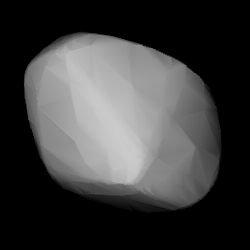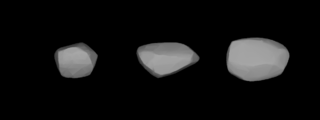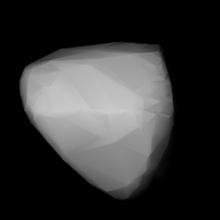
Bavaria is a carbonaceous background asteroid from the intermediate asteroid belt, approximately 54 kilometers. It was discovered by Johann Palisa on 16 November 1890 in Vienna.

Phyllis is a minor planet orbiting the Sun. It is an S-type asteroid with a diameter of 38 km and a geometric albedo of 0.185. Based on photometric observations between 1998 and 2006, it has a synodic rotation period of 4.293 ± 0.001 hours. The asteroid is named after Phyllis, a character in Greek mythology.
Violetta is a minor planet orbiting the Sun that was discovered by German astronomer Max Wolf on 26 January 1905 in Heidelberg. In light of M. F. Wolf's penchant ca. 1905 for naming asteroids after operatic heroines, it is likely that 557 Violetta is named after the protagonist of Giuseppe Verdi's famous opera La Traviata.
Nanon is a minor planet orbiting the Sun. At the time of its discovery, Max Wolf was habitually naming asteroids after operatic heroines, suggesting is it most likely named after the lead character of Nanon, an 1877 opera by Richard Genée.
Delila is a minor planet orbiting the Sun. It was named after the biblical character Delilah in Saint-Saëns's opera Samson et Dalila, which was first performed in German translation.
Suleika is a minor planet orbiting the Sun. Previously designated as 1905 QK, it was discovered by German astronomer Paul Götz on 6 April 1905 from Heidelberg, Germany.
Cheruskia is a minor planet, specifically an asteroid orbiting in the asteroid belt that was discovered by German astronomer Paul Götz on 26 July 1905 from Heidelberg.
Misa is a minor planet orbiting the Sun.
Kythera is a large, main belt asteroid orbiting the Sun. It was discovered in 1905 by German astronomer M. F. Wolf at Heidelberg, and was named after the Greek island of Kythira that is associated with Aphrodite. The object is a member of the Cybele asteroid group.
Reginhild is a minor planet orbiting the Sun that was discovered by German astronomer Max Wolf on September 19, 1905. The name may have been inspired by the asteroid's provisional designation 1905 RD.
Renate is a minor planet, specifically an asteroid orbiting in the asteroid belt which was discovered by German astronomer Max Wolf on September 19, 1905. The name may have been inspired by the asteroid's provisional designation 1905 RE.

Rebekka is a minor planet orbiting the Sun, which was discovered on September 19, 1905, by a German astronomer Paul Götz in Heidelberg. It was named after a young lady from Heidelberg, and may have been inspired by the asteroid's provisional designation 1905 RB.
Ingwelde is a Themistian asteroid. In light of Max Wolf's practice ca. 1905 of naming his discoveries after operatic heroines, it is most likely named after the title character of Ingwelde, an opera by Max von Schillings premiered in Karlsruhe in 1894.
Emanuela is an asteroid orbiting the Sun.

Happelia is a minor planet orbiting the Sun. On 24 February 2017 a possible small 3-kilometer moon was found orbiting the asteroid, based on occultation observations.
Sidonia is a minor planet orbiting the Sun that was discovered by the German astronomer August Kopff on November 3, 1905. It was named after a character in Christoph Willibald Gluck's opera Armide. The name may have been inspired by the asteroid's provisional designation 1905 SD.
Tauntonia is a dark Alauda asteroid from the outer region of the asteroid belt, approximately 61 kilometers in diameter.
Klotilde is a minor planet orbiting the Sun.
769 Tatjana is a minor planet orbiting the Sun. The body was named such after Tatiana Larina, protagonist of Alexander Pushkin's poem "Eugene Onegin". It's possible that the name was suggested by the provisional designation of the asteroid, 1913 TA, but unlike bodies named by Wolf, Knopff and Metcalf in the years 1905–1909, there's no naming pattern to support this.
3141 Buchar, provisional designation 1984 RH, is a dark Cybele asteroid from the outermost region of the asteroid belt, approximately 36 kilometers in diameter. It was discovered on 2 September 1984, by Czech astronomer Antonín Mrkos at the Kleť Observatory. The D-type asteroid has a rotation period of 11.4 hours. It was named in memory of Czechoslovakian astronomer Emil Buchar.




